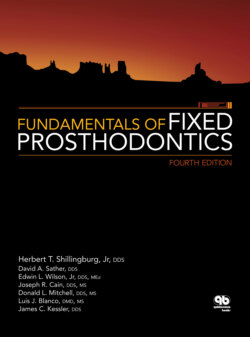Читать книгу Fundamentals of Fixed Prosthodontics - James C. Kessler - Страница 107
Conventional tooth-supported fixed partial denture
ОглавлениеWhen a missing tooth is to be replaced, a fixed partial denture is preferred by the majority of patients. The usual configuration for a fixed partial denture uses an abutment tooth on each end of the edentulous space to support the prosthesis. If the abutment teeth are periodontally sound, the edentulous span is short and straight, and the retainers are well designed and executed, the fixed partial denture can be expected to provide a long life of function for the patient. Several factors influence the decisions of whether to fabricate a fixed partial denture, what teeth to use as abutments, and what retainer designs to use (see Table 7-1).
There should be no gross soft tissue defect in the edentulous ridge. If there is, it may be possible to augment the ridge with grafts to enable the construction of a fixed prosthesis. This treatment is reserved for patients who are both highly motivated and able to afford this special procedure. If the patient does not meet these criteria, a removable partial denture should be considered.
A dry mouth creates a poor environment for any crown. The margins of the retainers will be at great risk from recurrent caries, limiting the life span of the prosthesis. However, an absence of moisture in the mouth also will hinder the success of a removable partial denture. In either case, the patient must be made aware of the high risk involved. The risk may be minimized through home fluoride application and frequent recall, but it cannot be eliminated.
